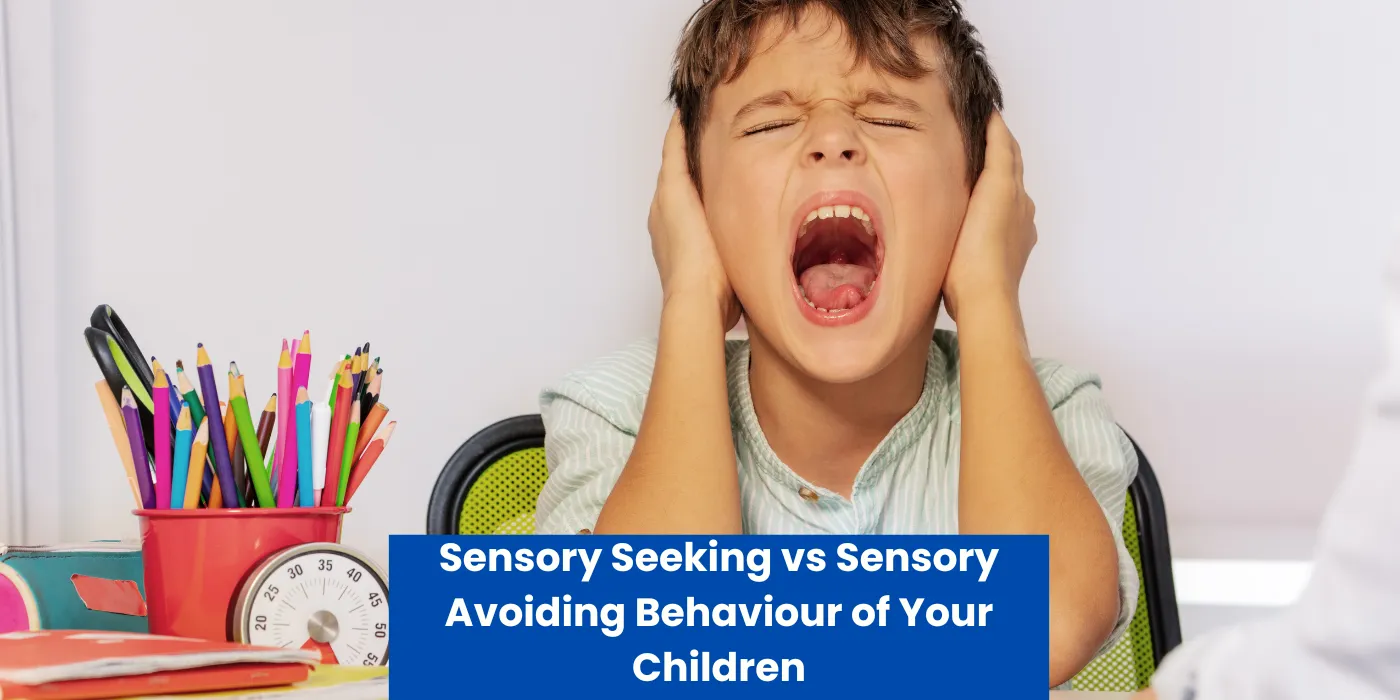Navigating the complex world of sensory seeking vs. sensory avoiding behaviors in children is crucial for understanding their unique needs and responses.
In this insightful exploration, we’ll delve into the nuances that distinguish sensory seeking children, who crave sensory input, from those who are sensory avoiding and might be overwhelmed by it.
Learn about the signs, implications, and strategies to support each type of sensory processing behavior. We’ll also touch on how parents, educators, and therapists can create environments that cater to both ends of the sensory spectrum.
Join us in uncovering the intricacies of sensory processing behaviors, paving the way for more supportive and understanding interactions with all children.
Key Takeaways: Sensory Seeking vs Sensory Avoiding Behavior in Children
Sensory Seeking Behavior
- Thrives on intense sensory input. Sensory seekers often look for activities or stimuli that provide a high level of sensory input, like loud noises, bright lights, or strong tastes and textures.
- Seeks constant movement. These children might constantly be on the move, enjoying activities like spinning, jumping, or roughhousing.
- Tends to touch objects and people. They might have a desire to touch everything they see and may not understand personal space boundaries.
- High pain tolerance. Sensory seeking children may have a higher than average pain tolerance.
- Often under-responsive. These children might appear under-responsive to stimuli that would typically elicit a strong response in others.
Sensory Avoiding Behavior
- Overwhelmed by sensory input. Sensory avoiders can easily become overwhelmed by stimuli that are too intense or chaotic, leading to stress or anxiety.
- Prefers quiet, calm environments. They tend to thrive in settings that are less stimulating and more predictable.
- Avoids physical contact. Sensory avoiding children might not like being touched and may shy away from hugs or physical games.
- Sensitive to certain textures. They may be particularly picky with clothing or food textures.
- React strongly to sounds, lights, or smells. Everyday sounds, bright lights, or strong odors can be distressing to sensory avoiders.
What Are The Types of Sensory Inputs
To comprehend sensory seeking vs sensory avoiding behavior, it is necessary first to comprehend sensory processing and the types of sensory input that can influence a child’s perception of the world around them, and also to consider what sensory processing disorder can look like.
Smell
Smell is a highly potent sensation that can elicit intense feelings and recollections. It is also closely related to flavor, as our ability to scent significantly impacts our ability to taste.
Powerful perfumes or cleaning products may overpower children sensitive to smell, while others may seek out pleasant odors such as blossoms or newly made biscuits.
Sight
One of the main methods we gather knowledge about our surroundings is through vision. Unfortunately, bright lights or crowded visual patterns can overwhelm children susceptible to light or visual stimulation.
On the other hand, children who desire visual stimulation may appreciate bright hues and patterns and visual experiences such as viewing movies or playing with light-up toys.
Taste
Taste is closely related to our perception of smell and is essential to our pleasure of sustenance. Children sensitive to flavor may be picky consumers or only ingest a restricted variety of meals.
On the other hand, children who seek out powerful flavors and textures may appreciate spicy meals, sour sweets, or other extreme tastes.
Touch
The physical feeling of contact and our perceptions of pressure, temperature, and texture are all part of our sense of touch. Children sensitive to touch may be bothered by certain textiles or garment textures and be averse to physical contact.

Roughhousing or playing with textured materials such as slime or playdough may appeal to children who desire touch sensory stimuli.
Hearing
Our hearing perception enables us to detect sound and speech, which is essential for conversation and social contact. However, sound-sensitive children may be overpowered by harsh sounds or background noise.
In contrast, children seeking aural stimulus may enjoy listening to music, creating a commotion, or participating in boisterous activities.
| Criteria | Sensory Seeking Children | Sensory Avoiding Children |
|---|---|---|
| Description | Children who actively seek out sensory experiences, often craving more intense or prolonged stimuli than peers. | Children who can be overwhelmed or distressed by sensory experiences and tend to withdraw or avoid them. |
| Behavioral Traits | – May appear restless or “hyperactive” – Often touch objects and people more than peers – Seek movement experiences, like spinning or rocking | – Startle easily or seem overly cautious – Dislike unexpected touches or certain textures – May cover ears in response to certain sounds |
| Physical Responses | – May not react to pain as quickly or might love intense sensations (like tight hugs) – Enjoy messy play, like playing in mud or with slime | – Can be picky eaters, avoiding certain textures or flavors – Might resist wearing certain clothing due to fabric sensitivities – May dislike having hair or face washed |
| Play Preferences | – Drawn to sensory-rich environments, like playgrounds or water play areas – Enjoy activities that involve movement, like trampolines or swings | – Prefer quiet or controlled play settings <br> – Might avoid group play, especially if loud or chaotic |
| Potential Challenges | – Difficulty sitting still or focusing in structured environments, like classrooms – Might not understand personal space, leading to potential social challenges | – May become overwhelmed in sensory-rich environments, leading to meltdowns or withdrawal – Challenges in trying new activities or adapting to changes in routines |
| Support Strategies | – Provide regular sensory breaks or activities (e.g., jumping, deep pressure) – Use of sensory tools, like fidget toys or weighted blankets | – Create calm and predictable environments – Offer sensory tools or strategies, like noise-canceling headphones or calming visual aids |
Balance, Propriocepion and Spatial Awareness
These are the forgotten “bonus” senses, which help us sense body movement as well as our own body in relation to the space around us.
Where Sensory seekers will seek out tight hugs, weighted blankets and small spaces such as dens and tents, sensory avoiders will prefer space and freedom, often resisting touch

Sensory Seeking Behaviour: Definition and Characteristics
The tendency of a child to seek out sensory input to actively regulate their body and emotions is known as sensory-seeking behavior. Sensory seeking behaviours can at times cause issues. Here are some sensory-seeking examples to watch out for.
Exceptional Pain Tolerance
Children with a greater pain tolerance may participate in activities others find unpleasant or painful, such as roughhousing or climbing. They may also be more sensitive to hot or chilly conditions and spicy meals.
Being Overly Close and Unaware of Personal Space
Children who seek sensory feedback may be unaware that they are standing too near or improperly handling others. As a result, this behavior may be perceived as impolite or invasive, but it is not done intentionally. Those in search of proprioceptive input may seek out tight hugs and rough play.
Stomping
Stomping or other repetitive motions can help toddlers feel anchored and regulated by providing a feeling of proprioception and deep pressure. This behavior may appear to others to be distracting or needless, but it is a means for the kid to satisfy their sensory requirements.
Making Loud Noises Intentionally
Children looking for auditory information may intentionally make noise to hear and feel the sound waves. They may also enjoy the bodily feeling of causing a commotion and the attention they receive from others.

Sensory Avoiding Behaviour: Definition and Characteristics
Sense-avoiding behavior refers to a child’s proclivity to avoid specific sense stimulation to feel calmer and in control. Sensory processing issues can manifest in various ways; here are some sensory-avoiding examples to be on the lookout for.
Being Frightened
Children who avoid sensory input may be easily startled by loud sounds or unanticipated events and feel overwhelmed or nervous in crowded or chaotic settings.
Touch-Resistant
Sensory avoiders may be sensitive to touch or physical contact and may become disturbed or distraught if handled abruptly or without notice. Sensory stimuli can cause extreme distress.
Concerned About Getting Bumped
Children who avoid sensory input may be excessively wary of their bodily surroundings, fearful of being bumped or hurt. They may also need help navigating bustling or congested areas.
Being More Acutely Aware of Background Noises
Children who ignore auditory information may be susceptible to background disturbances, such as the hum of a refrigerator or the sound of a fan, and these sounds may confuse or distress them.
Not Liking Swings, Slides, or Other Play Equipment
Certain kinds of movement or sensory input, such as the swinging motion or falling down a slide, may trigger feelings of uneasiness or anxiety.
Preferring Quieter Places
Children who avoid sensory input may prefer calm or low-stimulation settings and may become upset or overwhelmed in noisy or busy environments with too much in the way or sensory stimulation. Sensory tents with dim lights are popular.
These kids may also have a passion for being outdoors, enjoying quiet open space.

What Is the Most Common Misconception About Sensory Seeking vs. Sensory Avoiding Behaviour
A child’s fear of contact and sight does not imply that they are frightened of all sensory activities. This is a widespread misconception: sensory seekers pursue all sensory pursuits, whereas avoiders avoid all sensory activities.
Understanding the intricacies of sensory seeking vs. sensory avoiding habits in children can be game changers for parents and caretakers. We can help children flourish by dispelling prevalent myths and identifying their requirements.
How each child will experience sensory input will vary massively, so it’s important to cater treatment to the child. ideally with the help of a qualified specialised such as an occupational therapist. If you are ever in doubt about your child not meeting developmental milestones or any aspect of behaviour, be sure to reach out to your pediatrician.
So, the next time you find yourself disoriented in the sensory forest, whether you have sensory seeker or a sensory avoider, remember that you and your kid can accomplish anything with a little bit of information and perseverance!





